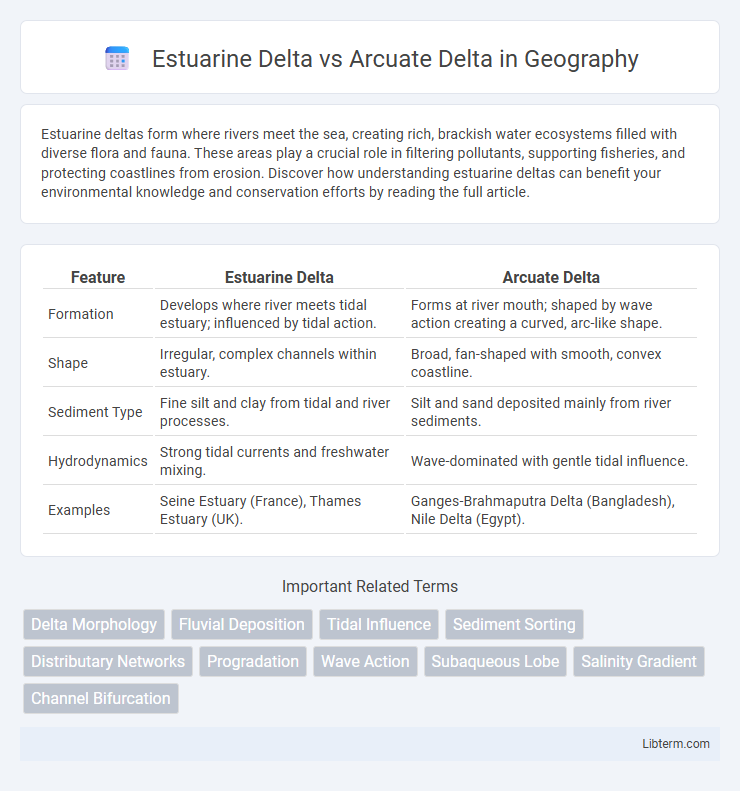Estuarine deltas form where rivers meet the sea, creating rich, brackish water ecosystems filled with diverse flora and fauna. These areas play a crucial role in filtering pollutants, supporting fisheries, and protecting coastlines from erosion. Discover how understanding estuarine deltas can benefit your environmental knowledge and conservation efforts by reading the full article.
Table of Comparison
| Feature | Estuarine Delta | Arcuate Delta |
|---|---|---|
| Formation | Develops where river meets tidal estuary; influenced by tidal action. | Forms at river mouth; shaped by wave action creating a curved, arc-like shape. |
| Shape | Irregular, complex channels within estuary. | Broad, fan-shaped with smooth, convex coastline. |
| Sediment Type | Fine silt and clay from tidal and river processes. | Silt and sand deposited mainly from river sediments. |
| Hydrodynamics | Strong tidal currents and freshwater mixing. | Wave-dominated with gentle tidal influence. |
| Examples | Seine Estuary (France), Thames Estuary (UK). | Ganges-Brahmaputra Delta (Bangladesh), Nile Delta (Egypt). |
Introduction to Delta Types
Estuarine deltas form where river channels deposit sediment into an estuary, mixing fresh and saltwater, creating complex sedimentary patterns influenced by tidal processes. Arcuate deltas feature a crescent-shaped coastline and develop where sediment load is evenly distributed by the river, typically seen in areas with moderate wave action that smooths the delta's shoreline. Understanding these delta types aids in coastal management and sedimentary environment analysis.
Defining Estuarine Deltas
Estuarine deltas form where river sediments accumulate at the mouth of a river within a partially enclosed coastal body of water, such as an estuary, resulting in significant mixing of freshwater and seawater. These deltas are characterized by extensive marshlands and tidal channels, which promote sediment deposition and habitat diversity. Unlike arcuate deltas, estuarine deltas develop in environments with pronounced tidal influence and reduced wave energy, leading to irregular, lobate sediment patterns.
Defining Arcuate Deltas
Arcuate deltas are fan-shaped landforms characterized by their smooth, convex coastline and multiple distributary channels spreading sediment evenly into the receiving basin. These deltas typically form where river sediment load is high and wave action redistributes sediments along the coast, creating a curved shoreline. In contrast, estuarine deltas develop within drowned river valleys, where tidal processes dominate sediment deposition and create a more funnel-shaped, less evenly spread landform.
Formation Processes of Estuarine Deltas
Estuarine deltas form through the deposition of sediment at river mouths influenced by tidal fluctuations and freshwater-saltwater interactions, creating complex sedimentary structures. These deltas develop in partially enclosed coastal bodies where riverine sediments accumulate due to reduced wave energy and tidal mixing. In contrast, arcuate deltas originate primarily from river sediment deposits spread radially at the coastline, shaped by strong wave actions evenly distributing sediments.
Formation Processes of Arcuate Deltas
Arcuate deltas form primarily through the deposition of sediment carried by rivers as they enter a standing body of water, such as a sea or lake, where wave action redistributes the sediment along the shoreline, creating a fan-shaped or arc-like outline. These deltas result from a balance between fluvial sediment supply and wave energy, leading to smooth, curved coastlines with multiple distributary channels. The sediment consists mainly of sand and silt, which accumulate progressively due to the constructive interference of wave dynamics with river outflow.
Sediment Deposition Patterns
Estuarine deltas exhibit sediment deposition patterns characterized by sediment accumulation influenced by tidal currents and fluvial processes, leading to complex intertidal zones with fine-grained sediments. Arcuate deltas display radial sediment deposition patterns where distributary channels spread sediment in a fan-shaped formation, primarily composed of coarser-grained materials from river discharge. These contrasting sedimentation dynamics influence delta morphology, with estuarine deltas showing layered, mixed sediments and arcuate deltas having well-defined, outward-spreading sediment lobes.
Ecological and Environmental Significance
Estuarine deltas provide critical habitats for diverse aquatic and terrestrial species, serving as nurseries for fish and breeding grounds for birds due to their mix of saltwater and freshwater environments. Arcuate deltas, characterized by their fan-shaped formation, support sediment-rich ecosystems that stabilize coastlines and foster productive wetlands essential for carbon sequestration and nutrient cycling. Both delta types play vital roles in mitigating flood risks, filtering pollutants, and sustaining biodiversity within their respective estuarine and marine ecosystems.
Notable Examples Worldwide
Notable examples of estuarine deltas include the Yangtze River Delta in China and the Thames Estuary in the United Kingdom, both characterized by their formation where river discharge meets tidal waters, creating rich, biodiverse wetlands. Arcuate deltas, such as the Nile Delta in Egypt and the Ganges-Brahmaputra Delta in Bangladesh and India, exhibit a fan-shaped, curved coastline formed by the symmetric deposition of sediments along coastlines with consistent wave action. These distinctive delta types support diverse ecosystems and serve as crucial hubs for agriculture, fisheries, and urban development worldwide.
Key Differences: Estuarine vs. Arcuate Deltas
Estuarine deltas form where river channels enter tidal estuaries, characterized by mixed sediment deposition influenced by both fluvial and tidal processes, resulting in complex, irregular landforms. Arcuate deltas develop at river mouths into open seas, exhibiting a fan-shaped, convex shoreline created by symmetrical sediment distribution driven primarily by river discharge and wave action. Key differences include the estuarine delta's adaptation to tidal dynamics and estuarine mixing zones, compared to the arcuate delta's consistent sediment dispersal and distinct arc shape.
Implications for Coastal Management
Estuarine deltas, characterized by sediment deposition within estuaries, require coastal management strategies that address fluctuating salinity levels and sediment accumulation to protect vital habitats and maintain water quality. Arcuate deltas, typically fan-shaped and formed at river mouths with strong wave action, demand coastal defenses designed to mitigate erosion and manage sediment distribution to preserve shoreline stability. Effective management must consider the unique hydrodynamics and sediment transport processes inherent to each delta type to sustain ecological balance and support human activities.
Estuarine Delta Infographic

 libterm.com
libterm.com